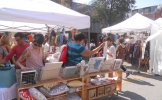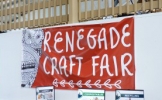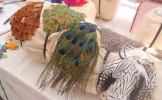Do you want your craft show application to stand out from the thousands of other indie business owners who are also vying for a spot? Check out these craft fair tips from show organizers around the U.S. to find out how your craft show application can end up in the “yes” pile:
Follow the Directions on the Craft Show Application
Read the FAQ and follow instructions to a T. If the organizers ask for web-resolution photos, don't send images that are 5MB each. If they say in the FAQ that you can't share a table, don't ask if you can share a table. Those little rules are in place to make the organizers' lives easier, and if you respect that, it's wholeheartedly appreciated! —Grace Dobush, Crafty Supermarket, Cincinnati, OH
Each show will have different requirements for their applications. Likely, they are making requests like that to streamline the jury process on their end, and if you don't follow the directions, some shows may simply exclude your application. —Amanda Mauer Taflinger, INDIEana Handicraft Exchange, Indianapolis, IN

How To Build an Artist Website
Sign up for our newsletter and get the book How to Build an Artist Website for free!
Be Unique
The quickest way to our hearts is to stand out with a unique craft we haven’t seen before. Crafters who come up with innovative ideas are a welcome change to looking at application after application with similar crafts. —Renegade Gang, organizers of Renegade Craft Fairs in Austin, TX; San Francisco and Los Angeles, CA; Brooklyn, NY; Chicago, IL; and London, England
Show a Cohesive Product Line on Your Craft Show Application
If you are an amazing screen printer, but a novice knitter, it is a good idea to only show us your best work, so as not to lower the level of cohesiveness and consistency in your application. —Renegade Gang
Submit images that show different products, but products that work together to create a cohesive product line. If you are primarily making sterling silver jewelry, but on occasion screenprint baby onesies, it's probably wise to exclude the onesies and focus on your strength and your largest body of work for a craft show application. —Amanda Mauer Taflinger
Submit Great Photos
Professional photography is one of the best investments you can make. If you can't afford to pay a professional to spend an hour or two shooting your offerings, put a call out to your friends to see if anyone has some background in photography on more than an amateur level. —Amanda Mauer Taflinger
If your pix are blurry or poorly lit, we can't see how awesome your work is. Including a picture of your table setup with your application photos is nice—that way we can see how your display would fit in at our show. —Grace Dobush
Have a Strong Web Presence
My pet peeves are being directed to 1. your blog (unless there is a clearly labeled gallery section with photos, separate from your posts), 2. your Facebook page, 3. your really poorly designed website with animated GIFS. On the flip side, [submit] a decent website with easy-to-find photos, a Flickr album (if you are going to submit this, the photos better be exemplary, because you are forgoing your branding), or an Etsy/hosted online shop. —Autumn Wiggins, Strange Folk Festival, O’Fallon, IL (near St. Louis, MO)
It's important to have a web presence. Not being able to give us a URL where we can see your work or learn more about you makes us wonder how serious you are about your craft business. —Grace Dobush
Show You’re a Professional
An application that exhibits professionalism and consistency in terms of business names, websites, and emails lets us know that you are taking your craft seriously, and we can count on you to be a great vendor at our fair. —Renegade Gang
OMG, do not use all-caps or all lower-case when filling out your online app. I dOn'T CaRe iF yOu tHinK ThiS LoOkS cUTe. Use proper capitalization, or be prepared for me to roll my eyes upon seeing your application. —Autumn Wiggins
Respect Organizers’ Time — and, Be Nice!
Long before applications go live, I clearly state on the website what date they will be available, and describe the process of being juried for acceptance. When people call or email me, asking about that basic info, it puts me in a foul mood. If there is some specific piece of logistical info you need, ask yourself if it's absolutely necessary to find it out before you have even been accepted. —Autumn Wiggins
If you get the dreaded "thanks but no thanks" email, making a scene is not a good way to make an impression. I've been rejected from craft shows, and being graceful about the rejection and moving on to the next project is the best way to cope. Sending off an angry email to the organizers is NOT a good move. —Grace Dobush

.JPG)



